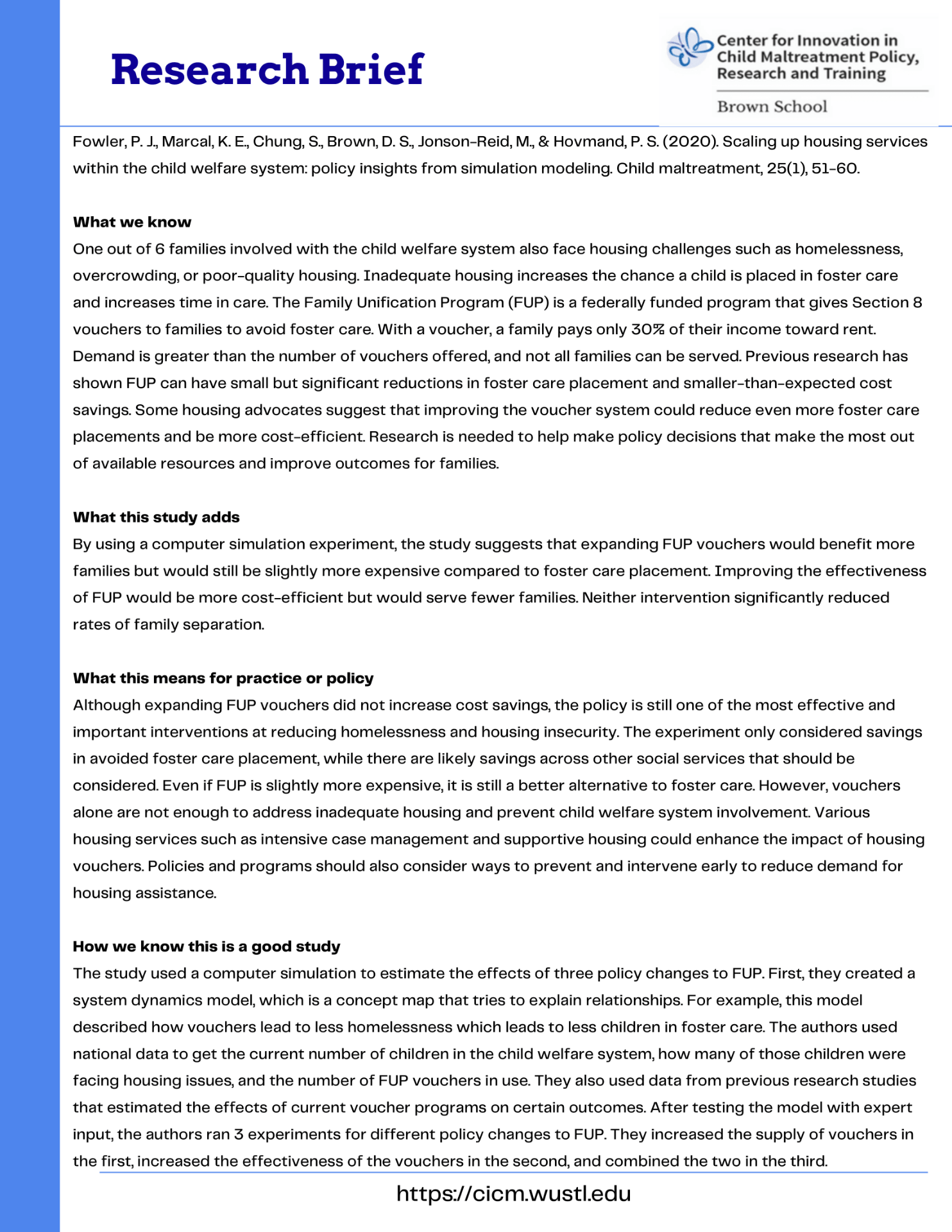Scaling up housing services within the child welfare system
Research Brief

Fowler, P. J., Marcal, K. E., Chung, S., Brown, D. S., Jonson-Reid, M., & Hovmand, P. S. (2020). Scaling up housing services within the child welfare system: policy insights from simulation modeling. Child maltreatment, 25(1), 51-60.
What we know
One out of 6 families involved with the child welfare system also face housing challenges such as homelessness, overcrowding, or poor-quality housing. Inadequate housing increases the chance a child is placed in foster care and increases time in care. The Family Unification Program (FUP) is a federally funded program that gives Section 8 vouchers to families to avoid foster care. With a voucher, a family pays only 30% of their income toward rent. Demand is greater than the number of vouchers offered, and not all families can be served. Previous research has shown FUP can have small but significant reductions in foster care placement and smaller-than-expected cost savings. Some housing advocates suggest that improving the voucher system could reduce even more foster care placements and be more cost-efficient. Suggested improvements include increasing the number of vouchers available or making them more effective (by targeting them to the neediest families, getting them to families faster, or adding on supportive services). Research is needed to help make policy decisions that make the most out of available resources and improve outcomes for families.
What this study adds
By using a computer simulation experiment, the study suggests that expanding FUP vouchers would benefit more families but would still be slightly more expensive compared to foster care placement. Improving the effectiveness of FUP would be more cost-efficient but would serve fewer families. Neither intervention significantly reduced rates of family separation. The high, constant demand for housing assistance is a major barrier to making sustainable improvements.
What this means for practice or policy
Although expanding FUP vouchers did not increase cost savings, the policy is still one of the most effective and important interventions at reducing homelessness and housing insecurity. The experiment only considered savings in avoided foster care placement, while there are likely savings across other social services that should be considered. Even if FUP is slightly more expensive, it is still a better alternative to foster care. However, vouchers alone are not enough to address inadequate housing and prevent child welfare system involvement. Various housing services such as intensive case management and supportive housing could enhance the impact of housing vouchers. Policies and programs should also consider ways to prevent and intervene early to reduce demand for housing assistance.
How we know this is a good study
The study used a computer simulation to estimate the effects of three policy changes to FUP. First, they created a system dynamics model, which is a concept map that tries to explain relationships. For example, this model described how vouchers lead to less homelessness which leads to less children in foster care. The authors used national data to get the current number of children in the child welfare system, how many of those children were facing housing issues, and the number of FUP vouchers in use. They also used data from previous research studies that estimated the effects of current voucher programs on certain outcomes. After testing the model with expert input, the authors ran 3 experiments for different policy changes to FUP. They increased the supply of vouchers in the first, increased the effectiveness of the vouchers in the second, and combined the two in the third.